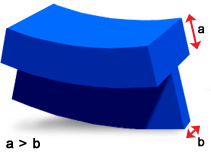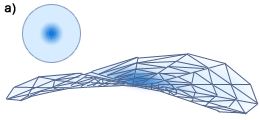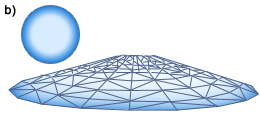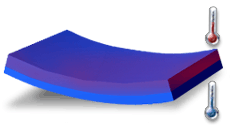There are several factors that could cause a part to distort.
When considering the contributors to warpage, it is convenient to identify shrinkage due to:
-
Variation in shrinkage from region to region (differential shrinkage).
-
Temperature differences from one side of the mold to the other (differential cooling).
-
Variations in the magnitude of shrinkage in directions parallel and perpendicular to the material orientation direction (orientation effects).
Each of these types of shrinkage will contribute to the total warpage of the product.
Differential Shrinkage
This type of shrinkage is often caused by variation in crystalline content and volumetric shrinkage. The following figure shows a thin rib attached to a thick top. In general, the cooling rate of the top will be lower than that of the thin section. The top will have increased crystalline content and therefore, will shrink more and cause the warpage shown.

The following figure (a) shows saddle warping of a centrally gated disk with high shrinkage around the gate. Conversely, if the shrinkage is higher around the outer part of the disk, the resulting warpage may cause the disk to dome, shown in (b).


High Shrinkage ![]()
Low Shrinkage
Differential Cooling
Shrinkage due to differential temperature typically results in bowing of the component, as shown in the figure below. Usually this type of shrinkage is due to poor cooling system design.

While the part is in the mold, temperature differences from one side of the mold to the other cause variations in shrinkage through the thickness of the component. In addition to this, any temperature differences at ejection will cause further warpage as both sides of the part cool to room temperature.
Orientation Effects
Orientation causes variation in the magnitude of shrinkage in directions parallel and perpendicular to the material orientation direction. This type of shrinkage can produce warpage similar to that of differential shrinkage. Figure (a) below shows the warpage when parallel shrinkage is greater than perpendicular shrinkage. On the other hand doming can be produced if the perpendicular shrinkage is higher than parallel shrinkage, see (b).

